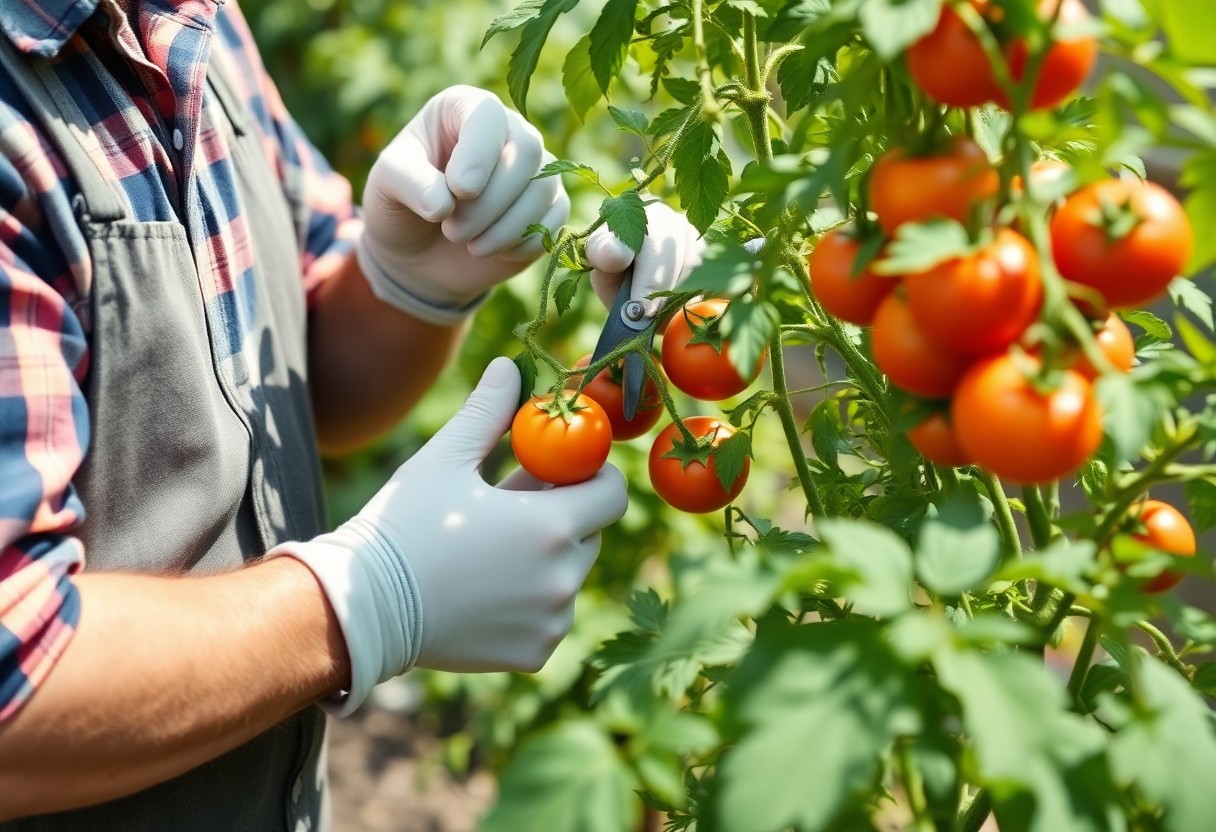
Over the course of the growing season, your tomato plants can become unruly, leading to less fruitful yields. Pruning your tomatoes is a simple yet effective way to encourage healthy growth while maximizing your harvest. In this guide, you’ll learn helpful tips and techniques to prune your tomato plants, ensuring they thrive in your garden. Grab your gardening shears, and let’s get started on giving your tomatoes the care they deserve!
Understanding the Basics of Tomato Pruning
A good understanding of tomato pruning is necessary for maximizing your plant’s growth and fruit production. By selectively removing certain parts of your tomato plants, you can encourage healthier growth, reduce disease risk, and improve airflow. This knowledge will empower you to make informed decisions about how and when to prune, ensuring your tomatoes thrive throughout the growing season.
Importance of Pruning
While it may seem unnecessary, pruning your tomato plants can significantly enhance their growth and vigor. By removing excess foliage, you promote better sunlight exposure and airflow, which helps reduce fungal diseases and pests. Additionally, pruning encourages stronger roots and healthier fruit development, leading to a more bountiful harvest.
Types of Tomato Plants
Understanding the types of tomato plants is key to effective pruning. The two main categories of tomato plants are determinate and indeterminate. Determinate varieties grow to a specific height and produce all their fruit at once, while indeterminate varieties continue to grow and produce fruit throughout the season.
| Type | Characteristics |
|---|---|
| Determinate | Fixed height, fruits ripen earlier |
| Indeterminate | Continuous growth, prolonged harvest |
| Vining | Requires support, strong vertical growth |
| Bush | Compact, needs less staking |
| Cherry | Small, sweet, great for snacking |
After identifying the type of tomato you are growing, you can tailor your pruning strategy accordingly. Each type may require different pruning techniques to optimize growth and yield, adapting your approach based on your variety’s growth habit and overall characteristics.
- You need to know your tomato’s growth style.
- Determinate plants are pruned differently than indeterminate.
- Cherry tomatoes often require less pruning.
- Regularly assess your plants to determine pruning needs.
- After identifying your tomato type, adjust your care practices accordingly.
Essential Tools for Pruning
While pruning tomatoes might seem straightforward, having the right tools can make the process much smoother and more efficient. You’ll want to keep your gardening tools organized and ready, as having the necessarys at hand will help you focus on making those perfect cuts for healthier plants. Essential tools include pruning shears, gloves, and even a small bucket to collect clippings. A little preparation goes a long way in ensuring your pruning session is productive and enjoyable.
Choosing the Right Tools
Now, when it comes to selecting your pruning shears, look for a high-quality pair that feels comfortable in your hand. Opt for sharp, clean blades that will make clean cuts without tearing the stems, as this helps promote healing for your tomato plants. Remember to check for durability and ease of use, as investing in the right tools can save you time and effort.
Safety Tips for Pruning
Clearly, keeping safety in mind during pruning is important to keep you and your plants in top shape. Here are some necessary safety tips:
- Wear protective gloves to shield your hands from thorns and sharp edges.
- Use sharp tools to minimize damage to your plants and avoid slipping.
- Be cautious where you place your hands while cutting to prevent accidents.
The more prepared you are, the safer your pruning experience will be!
Plus, being attentive to your surroundings while pruning is a good idea. Here are some additional safety practices to consider:
- Keep your workspace tidy to prevent tripping hazards.
- Ensure your tools are appropriately stored when not in use.
- Stay hydrated and take breaks if the weather is hot.
The more you prioritize safety, the more enjoyable and effective your pruning sessions will become!
When to Prune Your Tomatoes
You want to ensure your tomato plants thrive, so knowing when to prune is vital for optimal growth. Ideally, you should prune your tomatoes during the growing season, specifically when they reach about 12 to 18 inches tall. This helps to promote airflow and encourages stronger growth, benefiting your overall yield.
Ideal Timing
Clearly, the best time to prune your tomatoes is during the early morning or late afternoon when temperatures are cooler. This will help minimize stress on the plants and reduce the likelihood of disease. Pruning should be done every few weeks, allowing you to closely monitor their growth and health.
Signs Your Tomatoes Need Pruning
Any sign of overcrowding, yellowing leaves, or excessive suckers can indicate that your tomatoes are in need of pruning. By keeping an eye on your plants, you can help ensure they remain healthy and productive all season long.
Another indication that your tomatoes might need some attention is when the leaves begin to touch the ground or become too dense. Low-hanging leaves can hinder airflow and promote fungal diseases. By regularly checking your plants, you’ll be able to nip any potential issues in the bud, ensuring your tomatoes grow strong and fruitful.
How to Prune: Step-by-Step Guide
After you gather your tools and understand the basics, you can follow this structured approach to prune your tomatoes effectively:
| Step | Action |
| 1 | Identify suckers below the first flower cluster. |
| 2 | Use sterilized pruners to snip off the suckers. |
| 3 | Remove any yellowing or dead leaves. |
| 4 | Thin out crowded branches for better air circulation. |
Initial Pruning
Now that you know the basics, the initial pruning is all about establishing a strong foundation for your plants. Start when your tomato plants reach about 12 inches in height. Focus on removing suckers that grow in the leaf axils to encourage upward growth and better fruit production.
Ongoing Maintenance Pruning
For the best results throughout the growing season, ongoing maintenance pruning is important. You should aim to prune every few weeks, ensuring your plants remain healthy and well-structured.
Plus, as your plants grow, regularly check for unwanted side shoots and remove any unproductive or damaged leaves. This proactive approach not only shapes your plants for better sun exposure but also reduces disease risk and enhances airflow. By maintaining a routine, you will make a significant difference in the vigor and productivity of your tomato plants!
Tips for Effective Pruning
Your tomato plants will thrive when you prune them effectively. Here are some tips to keep in mind:
- Use sharp, clean tools to avoid infections.
- Prune in the early morning when the plants are less stressed.
- Remove suckers before they get too large.
- Focus on improving air circulation and sunlight exposure.
- Regularly check your plants for new growth that needs managing.
The right techniques can help maximize your yield.
Common Mistakes to Avoid
Clearly, pruning can be a bit daunting, leading many to make common mistakes. Avoid cutting too much foliage, as this can stress your plants and reduce their ability to photosynthesize. Additionally, don’t prune too late in the season, which can inhibit fruit development. Instead, keep your timing and pruning practices in check for healthier plants.
Best Practices for Healthy Growth
Common practices for ensuring healthy tomato growth include consistent watering, mulching around the base, and proper fertilization. Caring for your plants with these practices supports the benefits of pruning, allowing them to produce a bountiful harvest. Regularly monitoring their growth and adjusting your care routines can keep your tomatoes flourishing throughout the season.
With attention to detail and a little effort, you can create the optimal environment for your tomatoes to thrive. Make sure your plants receive adequate nutrients while staying well-hydrated, as these factors play a vital role in their overall health. Combine these practices with effective pruning, and you’ll be well on your way to enjoying a fruitful harvest.
Factors to Consider for Successful Pruning
Keep in mind that successful pruning goes beyond just snipping branches. Here are some factors to consider:
- Time of year
- Your specific tomato variety
- Plant growth patterns
- Overall plant health
- Presence of pests or diseases
Assume that understanding these aspects will set you up for a healthy, productive tomato harvest.
Plant Health
Little attention to your plant’s health can go a long way in ensuring successful pruning. Before making any cuts, assess your tomatoes for signs of stress, such as yellowing leaves or wilting. Healthy plants can better recover from pruning and yield abundant fruit.
Weather and Soil Conditions
If you want to optimize your pruning efforts, pay close attention to weather and soil conditions. Ensuring your plants have ideal growing conditions will enhance recovery and fruit production after pruning.
To maximize the benefits of pruning, conduct your task on a dry day when the soil is not overly saturated. This will help your plants heal faster and prevent disease. Additionally, understanding your local climate can guide you on when to prune, ensuring that your tomatoes can thrive in the conditions available to them.
To wrap up
Presently, pruning your tomato plants can significantly enhance their growth and yield. By keeping an eye on suckers and removing lower leaves, you promote better airflow and sunlight exposure. Don’t be afraid to get your hands dirty; pruning can be a satisfying way to engage with your garden. Regularly checking your plants will help you adapt your approach as they grow. Enjoy the process and watch your tomatoes flourish!







